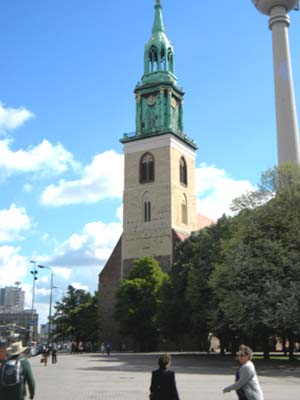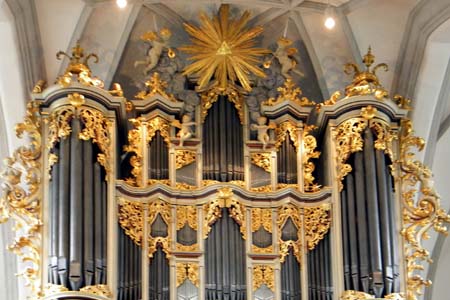| |
 |
 |
 |
| Comment on this report, or find other reports. |
 |
| Our Mystery Worshippers are volunteers who warm church pews for us around the world. If you'd like to become a Mystery Worshipper, start here. |
 |
| Find out how to reproduce this report in your church magazine or website. |
|
|
| 2182: Marienkirche,
Berlin, Germany |
 |
 |
 |
Mystery
Worshipper: Paterfamilias, accompanied
by Materfamilias and three of my in-laws.
The church:
Marienkirche,
Berlin, Germany.
Denomination:
Evangelical Church Berlin-Brandenburg-Silesian Upper Lusatia
(Evangelische
Kirche Berlin-Brandenburg-schlesische Oberlausitz).
This is one of the national member churches (Landeskirchen)
of the Evangelical Church of Germany (Evangelische
Kirche in Deutschland). Some Landeskirchen are Reformed,
some Lutheran, and some United. The church in the Berlin area
is United. The Marienkirche's heritage is Lutheran.
The building:
The current building dates from the late 13th century. It underwent
major changes during the Reformation and again in the 18th century.
Unlike many of Berlin's churches (as, for example, the Marienkirche's
neighbor, the Berliner Dom), the Marienkirche emerged from World
War II relatively unscathed. Many works of art from other churches
found a new home in the Marienkirche. A mural in the entranceway
from the late 15th century depicts the Dance of Death, a reminder
that all human beings are equal before Death. The mural had
been whitewashed over during the Reformation and was rediscovered
in 1860. Attempts to repair and improve, and then restore, the
mural have left it in poor condition today. One aspect I found
rather unusual: pews on the left hand side face forward, while
pews on the right hand side of the church face the center.
The church:
Marienkirchen is now the parish of St Peter and St Mary (St
Petri - St Marien), the result of merger with two other
parishes. Materials I picked up after the service refer to it
as the "sermon church for the bishop of the Protestant church
Berlin-Brandenburg-schlesische Oberlausitz." It is open daily,
although it does not receive as much attention on walking tours
as its much larger neighbor, the Berliner Dom. It celebrates
the eucharist each Sunday morning at 10.30, and holds an English
language service each Sunday evening at 6.00. There are three
choirs, and an extensive array of concerts.
The neighborhood:
Marienkirche is located on the Museum Island in the center of
Berlin. This area of town is dominated by a collection of museums,
such as the Pergamon, specializing in classical antiquities,
and the Bode, with an extraordinary collection of Byzantine
art.
The cast:
Celebrant and homilist was Superintendent Dr Berthold Höcker.
Hanns Jürgen Koch was lector. The church warden was Bernd Sawallisch
(his primary duty seemed to be that of chalice-bearer). Martina
Kürschner was organist. A second pastor, unnamed in the service
leaflet, stood at the altar during the eucharistic prayer and
assisted in the distribution of communion.
The date & time:
15 May 2011, 10.30am.
What was the name of the
service?
Service at St Mary's on Jubilate Sunday (Gottesdienst in
St Marien am Sonntag Jubilate).
How full was the building?
I am guessing that the building could seat 750-800, and it was
about 40 per cent full.
Did anyone welcome you personally?
We rushed in at 10.29, due to some confusion on my part as to
the church's location. A kindly woman handed us a hymnal and
service leaflet.
Was your pew comfortable?
Quite comfortable.
How would you describe the pre-service
atmosphere?
Quiet and reverential.
What were the exact opening words of the
service?
"Im Namen des Vaters und des Sohnes und des Heiligen Geistes."
What books did the congregation use during the
service?
Evangelisches Gesangbuch, and the aforementioned leaflet
with the order of service and most of the chanted portions of
the service.
What musical instruments were played?
Organ.
Did anything distract
you?
The hymnal. The melody line was accompanied only by the first
verse of text, with subsequent verses of text written below.
A couple of the tunes were classical Lutheran chorales that
I knew, but some were not, and in one instance the second and
remaining verses were on the following page (requiring a page
turn). I realize this sort of arrangement is not uncommon in
Europe, but it does not facilitate participation for the foreign
visitor.

Was the worship stiff-upper-lip,
happy clappy, or what?
A very formal, classically Lutheran liturgy. The celebrant was
vested in chasuble, the altar set with six candles and crucifix,
and much of the service was chanted. This was also an example
of a type of liturgy I doubt one would ever encounter in North
America: An authentic Orgelmesse, in which parts of
the service (the Gloria in excelsis and verses of some
hymns) were replaced by organ improvisations. Martina Kürschner's
extraordinary improvisations were prominent throughout the service,
whether replacing liturgical and hymn texts, serving as introductions
to hymns, or accompanying the entrance and exit processions
of the clergy. There was a soloist for the extended music before
the gospel (Gregorian alleluia, congregational hymn verse, chanted
verse, another congregational hymn verse, chanted verse, yet
another congregational hymn verse, and finally the Gregorian
alleluia again), but no choir. The eucharistic prayer was prayed
ad orientem, except that the celebrant and assisting
pastor turned and faced the congregation for the institution
narrative, which was beautifully chanted.
Exactly how long was the sermon?
11 minutes.
On a scale of 1-10, how good was the preacher?
9 – Very low key, with few hand gestures. However, whenever
he did gesture, it was very effective.
In a nutshell, what was
the sermon about?
The gospel for the day was John 15:1-8 ("I am the vine..."),
but the sermon was on John 16:20-23a ("Very truly I tell you,
you will weep and mourn...but your grief will turn to joy").
I couldn't make out a lot of the German, but Materfamilias tells
me that it incorporated a popular devotion that she has encountered
before, about the different fingers of the hand representing
the family, our responsibilities to ourselves, the workers,
etc.).
Which part of the service
was like being in heaven?
The organ playing was simply some of the most extraordinary
improvising I have ever heard. I found it so gratifying to realize
that the art of liturgical improvisation is not dead. And the
method of distributing communion I found quite moving. We gathered
in the area in front of the sanctuary in a circle, standing,
and communion was distributed by the celebrant, assisting pastor,
church warden, and lector. When all had been given communion,
we held hands with those to our left and right, and the celebrant
quietly prayed the post-communion prayer. It added a bit of
warmth, and created a real sense of community, in the midst
of a very formal liturgy.
And which part was like being in... er... the other place?
Nothing is hellish at Marienkirche. But obviously I wasn't fond
of the hymnal's arrangement. And I was surprised that a few
congregants got up and left prior to the communion part of the
service. Compared to North American Lutheran churches I attend,
there were some conservative touches: No sharing of the peace,
no reading from the Hebrew scriptures, and the intercessions
followed the offertory. It was also more clerically dominated
than what I am used to (although the lector read the gospel).
But this is their tradition, and they do it beautifully.
What happened when you hung around after the service looking lost?
We remained seated for Martina Kürschner's final improvisation,
as did the rest of the congregation. Materfamilias went about
her appointed duties of getting some additional photographs,
and I slowly walked toward the sanctuary area to get a closer
look. Then I bought a couple of pamphlets from a small bookshop
in the rear of the church, and finally left. All of the clergy
were at the rear of the church, and they chatted with us briefly,
wanting to know where we were from, etc. We were fairly easily
recognizable as foreign tourists. But as these are probably
a regular feature at Marienkirche, I suspect the members of
the regular congregation saw no need to engage us in conversation.
How would you describe the after-service
coffee?
There was none. We retired to a Vietnamese restaurant about
a block away and had a delightful lunch.
How would you feel about making this church your regular (where 10 = ecstatic, 0 = terminal)?
10 – Should I ever find myself living in Berlin, I would certainly start here, although perhaps with the Sunday evening English service.
Did the service make you feel glad to be a
Christian?
Absolutely.
What one thing will you remember about all this in seven days' time?
The extraordinary, atonal beginning of the improvisation preceding
"This Joyful Eastertide," which gradually blossomed into a spritely,
beautifully registered introduction of the tune. And the way
we received communion. |
|
|
 |
 |
 |
| We rely on voluntary donations to stay online. If you're a regular visitor to Ship of Fools, please consider supporting us. |
 |
 |
 |
| The Mystery Pilgrim |
 |
| One of our most seasoned reporters makes the Camino pilgrimage to Santiago de Compostela in Spain. Read here. |
 |
 |
 |
| London churches |
 |
| Read reports from 70 London churches, visited by a small army of Mystery Worshippers on one single Sunday. Read here. |
| |
|
|
|
|


